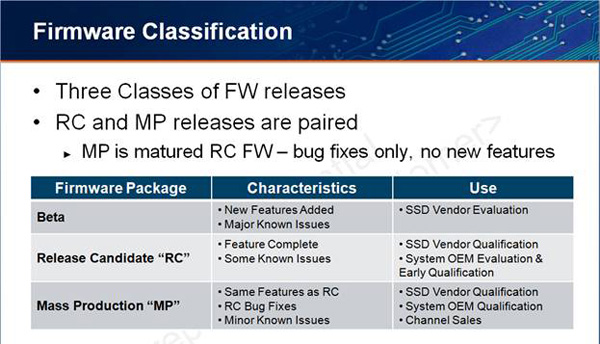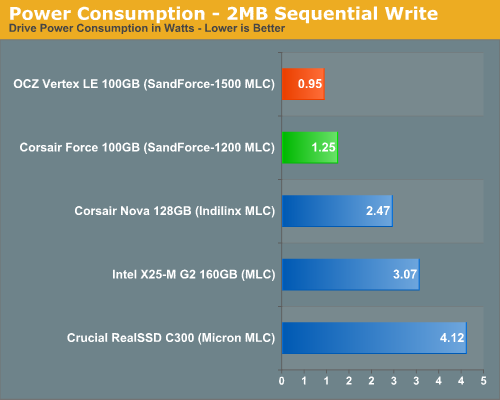Understanding SandForce's SF-1200 & SF-1500, Not All Drives are Equal
by Anand Lal Shimpi on April 16, 2010 11:30 AM ESTIt’s a Mad World: Not All SF-1200s Perform Alike
OCZ was the first from our community to really embrace SandForce. It’s my understanding that the two companies have a very close relationship, and OCZ has committed a lot of resources to SandForce and its products. OCZ took the early risk that others would not. While other companies are working with SF today, OCZ appears to have been the first from the SSD makers we cover on the site.
In exchange for their cooperation and support, SandForce gave OCZ a couple of things. First was the unique SF-1500 used in the Vertex LE at competitive prices (and minus some of the enterprise features). This gave OCZ a huge head start on the competition. The second thing SandForce gave OCZ was the rights to an exclusive firmware for the SF-1200. This firmware would give OCZ the small file random write performance of the SF-1500, but with the rest of the feature set of the SF-1200. This special firmware is going to be used in the upcoming Vertex 2 SSD.
The rest of SandForce’s customers would get the standard SF-1200 firmware, which allows the drive to run at 10,000 sustained 4K random IOPS. Other SF-1200 drives from OCZ, such as the upcoming Agility 2, would also use this standard SF-1200 firmware. The special firmware is only for the Vertex 2 at this point.
SandForce’s firmware has been in release candidate (RC) stage for the past couple of months. Internally SandForce calls this version 3.0.1 and has communicated to all of its partners what RC vs. MP (mass production) firmware entails:

This slide is shared with all SF partners.
Two things are true about this RC firmware: 1) it doesn’t limit small file random write speed on the SF-1200, and 2) there is a known reliability issue that could result in a dead drive (similar to what happened to my Vertex 2 Pro earlier this year).
And here’s where things get messy. SandForce distributed 3.0.1 to all of its partners (so much for that exclusivity agreement), and some of its partners have decided to sample reviewers or even ship based on 3.0.1. Note that even OCZ’s Vertex LE shipped using the SF-1500 version of this firmware. If SandForce indeed distributed the above slide to all of its partners, no drive should've shipped with RC firmware. That's a separate issue entirely and I've been working with both SandForce and the companies involved to see what we can do about curbing this (or at least get me the information so that I can make it clear when a product is using non-MP firmware).
The Corsair Force drive that has been sent out for reviews and that’s currently shipping today uses SandForce’s 3.0.1 firmware.
Naturally, I called up Corsair to figure out what’s going on. Corsair explained to me that the reliability problem was related to a power saving feature on the controller that Corsair simply disabled and thus avoided the issue entirely. I have yet to find a repeatable way to reproduce the bug, but the power data from our testing corroborates what Corsair is saying:

Corsair’s drive uses more power than OCZ’s Vertex LE. While it could be for a number of reasons, it’s apparently due to this power saving feature being disabled. Unless I’m wrong, Corsair appears to have circumvented the known reliability issue and is shipping product it feels is safe into the market.
Now we get to the other problem. The performance of 3.0.1 is the same as OCZ’s exclusive SF-1200 firmware, because the firmwares are the same. However SandForce has recently released its first MP firmware: 3.0.5. This firmware, as you’d expect, caps small file random write performance on all SF-1200 drives except for the Vertex 2 in accordance with SandForce’s agreement with OCZ. The SF-1500 version of this firmware doesn’t change performance, but it does supposedly fix the reliability problems and is available for Vertex LE owners here.
Corsair is currently testing the 3.0.5 revision for its drive but hasn’t shared it with me yet. Corsair wasn’t aware that performance dropped with this revision until I called yesterday. The release notes don’t indicate anything of the sort, Corsair was kept completely in the dark on this. Why didn’t SandForce tell Corsair? Because although it drops performance, the new firmware still runs the SF-1200 at its intended spec. The chip will continue to perform as advertised, just slower than with the RC firmware and slower than OCZ’s Vertex 2.










81 Comments
View All Comments
Barshj - Friday, April 16, 2010 - link
Great info, Anand! I have been a reader of yours since the beginning and have appreciated all your work! This is my first comment. I have been thiinking about getting a Sandforce drive since your first vertex 2 article and quickly decided to go get the ocz limited edition for a good price from newegg before they sell out. You probably did ocz a good service by talking about this as they will probably sell out quickly now.One thing I continually wonder regarding ssd reviews is why you need to publish the "new" drive test results rather than just testing and publishing your findings on a "used" drive. Soon enough all of us ssd owners will have their drives in the "used" condition so the "new" drive results are somewhat irrelevant to us buyers. It would probably make your job easier and tend to force vendors to ensure their drives hold up well after use, if you just conditioned the drive into a "used" state and only publish those results.
529th - Friday, April 16, 2010 - link
Does the OCZ Toolbox now work with the Vertex LE ??ClagMaster - Friday, April 16, 2010 - link
I always though firmware was the Achilles heel of these SSD’s and have a profound effect on performance. I expressed in earlier posts that it’s a bad situation when the many SSD vendors do not have a clue how their firmware works and rely on third-party vendors. Although, to be fair, Corsair knew enough about this Release Candidate Firmware to turnoff the power bug, then sold their SSD's as if the Release Candidate Firmware was the Production Firmware.Are you sure SandForce is culpable here. SandForce gave Corsair the Release Candidate Firmware so they could do development work with their SSD’s and perfect them for market. But its Corsair who decided to ship this RC firmware on its SSD’s. I am not satisfied the key players in the SSD industry have their configuration control together.
krazyderek - Friday, April 16, 2010 - link
where does OCW stand in terms of firmware? i had one of their 50gb drives at the top of my list, did they just disable the power saving feature as well, can anand include the OCW drives in the power draw metric and make an educated guess?in terms of "new technologies" and reliability, i've had a 2007 raptor and a foxconn retail motherboard both die in two different machines in my office this week, i don't think SSD's are any less an option then your typical HDD, i mean just look at the reviews on newegg to see how many HDD's arrive DOA, or brick after a month, granted, it's probably a lower percentage since it's a bigger market then SSD right now, but i think trying new controllers just comes with SSD territory right now, as you've pointed out in the past, every controller manufacturer worth looking at in the enthusiast field has had problems, and they're always covered under warranties, like you say, just keep a clone image of your drive ready for a couple of months when you first give SSD's a go.
willscary - Friday, April 16, 2010 - link
I am sorry to those readers and also to Anand, who may be tiring of this, but I just read my new (arrived today via mail) PCWorld. The inside back cover is a full page OWC advertizement touting the Mercury Extreme SSD. The specs are clearly the SF 1500 specs, incuding 10 million hr MTBF and less than 1 sector per 10^17 bits read. I know how long ago they finalized this ad (a few weeks) and how long since print (perhaps a week), but still.I only wish that everyone knew the true facts as this is dishonest. Again, I will also say that OWC was great when I ordered and quick to RMA, even though the guy who set up the RMA seemed VERY annoyed with my questioning of the controller.
cditty - Friday, April 16, 2010 - link
I can't see why anyone would want a Sandforce drive... It is more expensive per Gigabyte that the Intel. That is crazy. The Intel drives are proven (as proven as an SSD can be) drives that deliver great performance. I use G2's in my laptop and desktop and have been using their 40 Gigabyte value drives for boot drives in systems at work that need an extremely fast boot time. I would never trust my data to a 'new' controller. I don't even fully trust it to Intel yet, as I keep a nightly backup on a platter based RAID 1.iwod - Saturday, April 17, 2010 - link
Do you actually feel the difference between an C300 SSD, Intel SSD and a SandForce SSD?Ofcoz on paper SandForce would be the best, but does it actually gives anymore precipitable performance difference? From HDD to SSD was like from Horse to Racing Cars. But what if i already had a Intel SSD?
Also, any news on when are we expecting SATA 3.0 ( 6Gbps ) based SSD? It seems SATA 2.0 is the bottle neck right now.
soundseeker - Saturday, April 17, 2010 - link
can some onem please make clear: Are these points about the self cleaning aspects of the drive relevant to MAC OS. The big worry about getting a macbook pro with a SSD is you pay crazy amounts and then it deteriorates because Mac doesnt support TRIM.Anand and the guy with the 3 ssd's on order, are you installing the drives in Macs????
thanks
willscary - Saturday, April 17, 2010 - link
All of the SSDs that I have plus the 3 that I have on order are for PCs and all of the PCs are running Windows 7 Professional. I am sorry, but I can not help you with their long term health in a Mac environment.soundseeker - Sunday, April 18, 2010 - link
thanks for your answeranyone help verify the mac thing. is there no answer coz you are mostly pc users?
Im confused about the best approach for mac.- fill issues, controller issues and there's been no verification yet as to who manufactures the Apple stock SSD's. so this is a minefield of speculation